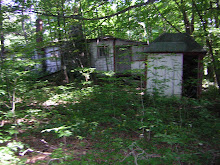
This is a story about a prophet; a Mohammed who went to the Mountain, and delivered down a dire warning about the future. It’s also a story about the calamity that followed, for you cannot have a prophet without some calamity.
The mountain happens to be Beartown Mountain, in Lee, and the prophet’s name was Levi Beebe. Some say his ghost still haunts the mountain, but that’s just the side note that brought the story to my attention.
Beebe was born in Richmond, in 1817. In his youth, he studied the paper business at the Platner & Smith mill in Lee. Due to poor health, he had to give up that vocation, and subsequently bought 2000 acres on Beartown (so named for a bear shot on his property). There he ran a small sawmill, and in his spare time studied the weather.
Over many years, he went from being something of an eccentric mountain hobbyist to a legendary figure, locally referred to as the “Weather Prophet” or “Prophet of Beartown Mountain.” Locals eagerly awaited his pronouncements, and farmers throughout the region came to plan their planting around them.
Eschewing “fancy” equipment, Beebe used only rigorous observation and note-taking.
“Greylock is my barometer!” he wrote, and from observing it, 38 miles to the north, he would gauge the content of gases in the atmosphere according to his own theories. Most unique was his assertion that the overall weather for a season could be measured by observing that of the last twenty days of the previous season. For instance, if in the last twenty days of December, snow accumulated and cold hardened it, he predicted a cold winter. If it came and went during those days, he predicted a broken winter.
His most famous success was in accurately predicting the Great Blizzard of 1888, one of the most severe storms in U.S. History. The previous fall, Beebe forecast that a terrible storm would strike on March 12 of the coming year.
By early March, the weather was unseasonably warm, and many had forgotten or shrugged off the Beartown hermit’s prediction. A decent number of locals who had come to swear by Beebe’s proclamations, however, had stocked up considerable fuel and food.
It came to pass that Sunday, March 11, began with a cold rain, gradually becoming a steady downpour. Temperatures dropped throughout the day, and rain mixed with sleet, then steady snow beginning in earnest just after midnight March 12.
It came to be called the Great White Hurricane, two days of freezing winds and heavy snowfall that paralyzed much of the Northeast. Upward of 50 inches fell in Massachusetts and Connecticut, with only slightly less in New York. Sustained winds buried everything in towering snowdrifts, making train and even road travel virtually impossible. Telegraph infrastructure was knocked out, cutting off major cities from Montreal to Washington, D.C. for days. More than 400 died in total, 200 in New York City alone.
In Pittsfield, the thermometer was at two below by Monday morning, with heavy drifts already impeding even sleigh traffic. Nonetheless, businesses opened, and most actually stayed open until the customary 6pm. The gas lamps were lit along North Street in the late afternoon, but all except two blew out immediately. By evening, the streets were completely deserted.

On Tuesday, almost no travel was possible. Average snowdrifts ranged from waist to shoulder deep; in places snow went higher than a person’s head, eclipsing the first floor level of some buildings. Nothing opened. The few mill employees who attempted to go on working became trapped inside their factories.
An even grimmer situation was developing on Washington Mountain, where Monday a passenger train had become stuck on the tracks and gradually became buried in the drifts. A short-range train, it had no dining car and the only food aboard consisted of a crate of 300 eggs. Four intrepid passengers managed to climb out of the car, then trek through blinding and sub-zero temperatures to get some bread from a nearby house. The seventy two passengers aboard got by on that and raw eggs, until Tuesday night, when the fuel ran out.
Finally, three Boston & Albany engines coupled together pushed through late that night, in time to rescue them from certain death by exposure.
When the snow stopped on Wednesday, drifts in Pittsfield ranged from 10 to 30 feet high. Overall, though, Berkshirites had stood up well. Some of that should no doubt be credited to the Prophet of Beartown Mountain.
Accordingly, his fame grew, and later predictions were published in papers throughout the country as he made them. In 1892, he published a booklet summarizing his contributions, the boldly titled Meteorology: How to Foretell the Weather for All Time in All Parts of the World. He also wrote weather reports for National Geographic and various New York papers.

As for his ghost haunting the mountain where his house once stood, I’ve never really heard anything but the vaguest mentions of it. I’m not sure anyone’s actually ever claimed to have personally seen anything odd there. More likely, this is a vague remembrance of a 1946 story by the Eagle’s Richard Happel, in which he uses the character of a ghost of Beebe to write a cute, educational piece about the changes in weather science since his day.
Even without haunting anything, his influence continues to this day. For though his name has largely been forgotten, there are still some farmers all over the country who continue to use his 20-day seasonal prediction method, never realizing that it originated with the Berkshires’ own Weather Prophet.
Joe Durwin is a Pittsfield native who is much more afraid of snow than of ghosts.
Please feel free to send stories of extraordinary local individuals and your own weather predictions (positive only please) to mysterioushills@gmail.com










